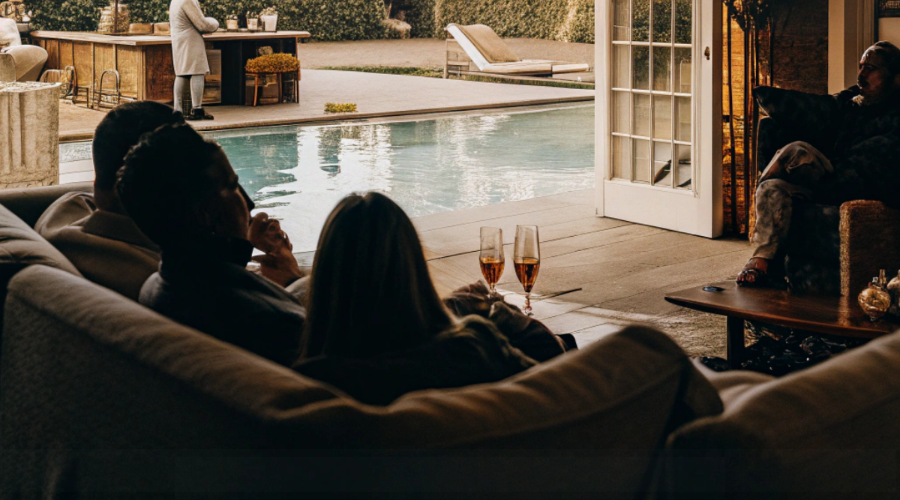Having a swimming pool on your lawn and depending on the main building to access every need can be overwhelming. Imagine a space right next to your swimming pool, where you can relax, entertain, and have some private space for yourself, without entering your home. Sounds tempting right? If that’s the case, then a pool house is what you need. It provides everything you need to fulfil your needs in the poolside area. Let’s take a deep look at pool house and whether it’s the perfect addition to your home.
What is A Pool House?
A Pool house is a small structure or building that is built near a swimming pool to provide comfort, convenience and functionality for pool users. It often acts as a pool-sided store room to occupy pool-related equipment, and also for functional purposes as a changing room, lounge area, or entertainment purposes. There is no specific size and design for pool houses, as they range from simple sheds to luxurious and fully equipped guesthouses. Along with the design and functionality, it’s important to consider Swimming Pool Rules and Regulations to ensure safety and compliance.
Why Do You Need A Pool House?
Privacy
A pool house provides a sense of privacy for changing clothes, showering, or even taking a rest, without entering the main house. This is especially helpful for guests and during swimming pool parties, offering more comfort and convenience with the secluded area away from the main living area.
Convenience
It acts as a convenient storage area to hold towels, drinks, or snacks. It acts as a central spot that provides everything while being in the pool from drying to storing pool equipment. This makes it easier to use, instead of depending solely on the main living area.
Storage
It helps in storing utilities such as cleaning tools, chemicals, towels, inflatables and other pool suppliers. It helps in organizing the pool area and to clutter away from the rest of the yard.
Entertainment and Socializing

It can act as an entertainment hub, offering guests the necessary amenities such as lobbies, bars, lounges, and party spaces. The pool house can be used as an extension of the outdoor space for socializing, dining, celebrations and parties.
Added Property Value
Adding a pool house in your courtyard enhances the overall look, adding luxuries to the property. Pool houses can be attractive for potential buyers, which drastically increases the resale value.
Comfort
The pool house gives a dedicated space to relax and cool down after swimming to make it more comfortable and enjoyable. Adding comfortable seating, a bathroom, and a heating system gives the necessary comfort near the pool.
All Weather Purpose
Pool houses can be used in all types of weather conditions when designed with necessary insulation and heating or cooling systems. Adding the cooling system can improve the usability and comfort of the pool users.
Advantages and Disadvantages of Pool House
Advantages
- It enhances the overall comfort of indoor swimming pool users with adequate requirements, without depending much on the main house.
- It enhances privacy by offering a secure place for changing, bathing, and relaxing.
- It helps organize the pool area with the necessary equipment and supplies neatly stored.
- A well-designed pool house significantly increases the property value, which helps in a high resale value.
- It can be used for various purposes as a guest house, party area, bar, or outdoor dining.
Disadvantages
- The cost of construction of a pool house can be expensive, due to the need for high-end materials that offer waterproofing.
- They are prone to spills and water penetration, requiring regular maintenance including cleaning, painting and repairs.
- Building a pool house requires adequate spacing to accommodate the structure, which is practically impossible for compact properties.
- The construction of a pool house requires permits and approvals from the local authorities.
How to Design Your Pool House?
Understanding the Purpose
Understand the needs for the primary usage of the pool house, whether it is for changing, storage, or conventional usage. Determine how big the pool house needs to be to accommodate to perform desired functions and features. Consider the budget, how much you can afford for construction and materials.
Style and Layout
Select a style that best compliments your housing space, architecture, and the overall landscape. Plan the layout for the pool house considering the needs, essential features, and the potential traffic flow.
Selecting Materials
Select the materials that are durable, low maintenance and provide the aesthetic value that complements the chosen style and layout. Ensure that the materials ticks all the boxes, as any compromise could be overwhelming, resulting in frequent maintenance or repair.
Comfort
Provide comfortable seating to accommodate the traffic for more relaxing and socializing. Install adequate lighting for both daytime and nighttime use. Ensure proper ventilation to prevent moisture buildup and maintain a comfortable temperature.
What Can be Added To A Pool House?
- Changing Rooms and Toilets: A separate changing area for men and women, which is equipped with showers, toilets, and sinks.
- Kitchenette: A small kitchenette with a sink, refrigerator, microwave, grill, and sink for outdoor cooking and dining.
- Bar Area: A countertop with seating to serve drinks and snacks.
- Lounge: A comfortable seat and tables in the lounge for relaxing and socializing.
- Storage Space: Built-in cabinets and shelves to store pool-related equipment and accessories.
- Fireplace: A dedicated fireplace to keep the pool area warm during the cooler evenings.
Conclusion
A pool area can be a valuable addition to any property that offers privacy, convenience and functionality. It is a dedicated space for multiple purposes, from changing, storing, and socializing to entertaining guests and hosting pool parties. A well-designed pool house that offers sophistication and visual appeal, adds more value to the property. However, building it can be expensive and requires additional accommodation space.

